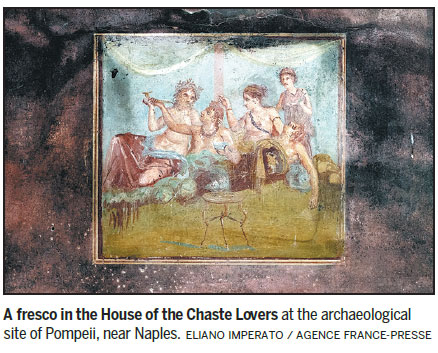Pompeii's legacy of love lost in lava
By Agence France-Presse in Pompeii, Italy (China Daily) Updated: 2017-02-11 07:15The lava may have cooled 2,000 years ago, but Pompeii is a hot destination this Valentine's Day with a special opening of the exceptionally preserved House of the Chaste Lovers.
This rich baker's dwelling, complete with garden, stables, mill and a sumptuous fresco of a tender kiss, stands on via dell'Abbondanza, the once-bustling thoroughfare of this ancient Roman city.
It also boasts the grinning skeletons of petrified mules caught in the eruption of Mount Vesuvius in 79AD.
Visitors will be able to snatch a rare glimpse this weekend of the 1,500-square meter site.

After Feb 14 it will close its doors for a four-year restoration as part of a multimillion dollar Pompeii preservation project.
"The complex encapsulates both the beauty and the challenges of Pompeii," said archaeologist Alberta Mattelone, 40.
"There is the archaeological heritage - the houses and frescoes - as well as the traces of the eruption, the volcanic deposits. Then there are the conservation problems - roofing, escarpments, preserving the frescoes."
The kiss decorates one of the walls of the triclinium, the small dining room where ancient Romans lounged on couches to eat and drink.
Whether the menu was cheese and honey or dormice, it was usually accompanied by freshly baked bread.
Next to the triclinium sits the bakery, with its stones used to ground the grain and a large oven where flat, round loaves scored across the top were prepared and sold at a little shop next door.
Just inside the shop's doorway are the scribbled running tabs of customers who still owe the baker money for bread they munched along with dried fruits and olives sold at the food stall opposite.
Frozen in time
The stone mill was driven by six mules and a donkey kept in the stable - and frozen in time when the molten rock and ash hit.
"They were analyzed by an archaeozoologist," said Mattelone. "They suffocated, all apart from one killed by a blow to the head as the building collapsed."
The four-legged creatures were "in an excellent state of conservation," she added.
Behind the stable lies the House of the Painters at Work, where decorators were partially through sprucing up a room when the volcano erupted, as well as a garden which is being recreated exactly as it was, thanks to archaeo-botanists.
The complex was first explored in 1912, unveiling a balcony later damaged by Allied bombs in World War II.
- 'Cooperation is complementary'
- Worldwide manhunt nets 50th fugitive
- China-Japan meet seeks cooperation
- Agency ensuring natural gas supply
- Global manhunt sees China catch its 50th fugitive
- Call for 'Red Boat Spirit' a noble goal, official says
- China 'open to world' of foreign talent
- Free trade studies agreed on as Li meets with Canadian PM Trudeau
- Emojis on austerity rules from top anti-graft authority go viral
- Xi: All aboard internet express











